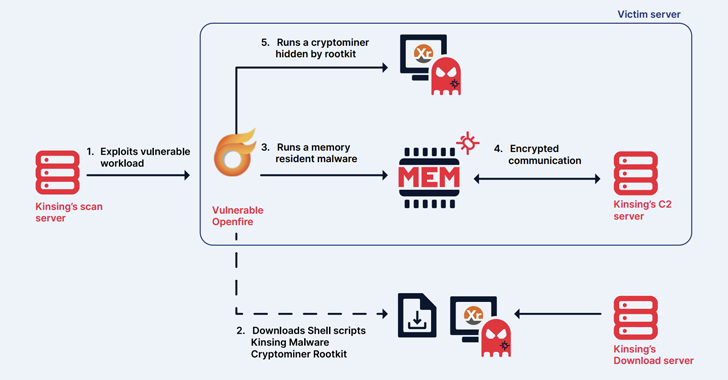Beware: 1,000+ Fake Cryptocurrency Sites Trap Users in Bogus Rewards Scheme

A
previously
undetected
cryptocurrency
scam
has
leveraged
a
constellation
of
over
1,000
fraudulent
websites
to
ensnare
users
into
a
bogus
rewards
scheme
since
at
least
January
2021.
“This
massive
campaign
has
likely
resulted
in
thousands
of
people
being
scammed
worldwide,”
Trend
Micro
researchers
said
in
a
report
published
last
week,
linking
it
to
a
Russian-speaking
threat
actor
named
“Impulse
Team.”
“The
scam
works
via
an
advanced
fee
fraud
that
involves
tricking
victims
into
believing
that
they’ve
won
a
certain
amount
of
cryptocurrency.
However,
to
get
their
rewards,
the
victims
would
need
to
pay
a
small
amount
to
open
an
account
on
their
website.”
The
compromise
chain
starts
with
a
direct
message
propagated
via
Twitter
to
lure
potential
targets
into
visiting
the
decoy
site.
The
account
responsible
for
sending
the
messages
has
since
been
closed.
The
message
urges
recipients
to
sign
up
for
an
account
on
the
website
and
apply
a
promo
code
specified
in
the
message
to
win
a
cryptocurrency
reward
amounting
to
0.78632
bitcoin
(about
$20,300).
But
once
an
account
is
set
up
on
the
fake
platform,
users
are
requested
to
activate
the
account
by
making
a
minimal
deposit
worth
0.01
bitcoin
(about
$258)
to
confirm
their
identity
and
complete
the
withdrawal.
“While
relatively
sizable,
the
amount
necessary
to
activate
the
account
pales
in
comparison
to
what
users
would
get
in
return,”
the
researchers
noted.
“However,
as
expected,
recipients
never
get
anything
in
return
when
they
pay
the
activation
amount.”
A
public
Telegram
channel
that
records
every
payment
made
by
the
victims
shows
that
the
illicit
transactions
have
yielded
the
actors
a
little
over
$5
million
between
December
24,
2022,
and
March
8,
2023.
Trend
Micro
said
it
unearthed
hundreds
of
domains
related
to
this
fraud,
with
some
of
them
being
active
as
far
back
as
2016.
All
the
fake
websites
belong
to
an
affiliate
“scam
crypto
project”
codenamed
Impulse
that’s
been
advertised
on
Russian
cybercrime
forums
since
February
2021.
Like
ransomware-as-a-service
(RaaS)
operations,
the
venture
requires
affiliate
actors
to
pay
a
fee
to
join
the
program
and
share
a
percentage
of
the
earnings
with
the
original
authors.
To
lend
the
operation
a
veneer
of
legitimacy,
the
threat
actors
are
believed
to
have
create
a
lookalike
version
of
a
known
anti-scam
tool
known
as
ScamDoc,
which
assigns
a
trust
score
for
different
websites,
in
a
plausible
attempt
to
pass
off
the
sketchy
crypto
services
as
trustworthy.
Trend
Micro
said
it
also
stumbled
upon
private
messages,
online
videos,
and
ads
on
other
social
networks
such
as
TikTok
and
Mastodon,
indicating
that
the
affiliates
are
using
a
wide
range
of
methods
to
advertise
the
fraudulent
activity.
“The
threat
actor
streamlines
operations
for
its
affiliates
by
providing
hosting
and
infrastructure
so
they
can
run
these
scam
websites
on
their
own,”
the
researchers
said.
“Affiliates
are
then
able
to
concentrate
on
other
aspects
of
the
operation,
such
as
running
their
own
advertising
campaigns.”
UPCOMING
WEBINAR
🔐
Mastering
API
Security:
Understanding
Your
True
Attack
Surface
Discover
the
untapped
vulnerabilities
in
your
API
ecosystem
and
take
proactive
steps
towards
ironclad
security.
Join
our
insightful
webinar!
News
of
the
fake
giveaway
scam
coincides
with
a
fresh
wave
of
cryptocurrency
stealing
attacks
orchestrated
by
a
threat
actor
dubbed
Pink
Drainer
that
has
been
found
to
masquerade
as
journalists
to
seize
control
of
victims’
Discord
and
Twitter
accounts
and
promote
spurious
crypto
schemes.
According
to
statistics
gathered
by
ScamSniffer,
Pink
Drainer
has
successfully
compromised
2,307
accounts
as
of
June
11,
2023,
to
steal
more
than
$3.29
million
worth
of
digital
assets.
The
findings
also
come
weeks
after
Akamai
took
the
wraps
off
a
renewed
Romanian
cryptojacking
campaign
named
Diicot
(previously
Mexals)
that
employs
a
Golang-based
Secure
Shell
(SSH)
worm
module
and
a
new
LAN
spreader
for
propagation.
Then
last
month,
Elastic
Security
Labs
detailed
the
use
of
an
open-source
rootkit
called
r77
to
deploy
the
XMRig
cryptocurrency
miner
in
several
Asian
countries.
“r77’s
primary
purpose
is
to
hide
the
presence
of
other
software
on
a
system
by
hooking
important
Windows
APIs,
making
it
an
ideal
tool
for
cybercriminals
looking
to
carry
out
stealthy
attacks,”
the
researchers
said.
“By
leveraging
the
r77
rootkit,
the
authors
of
the
malicious
crypto
miner
were
able
to
evade
detection
and
continue
their
campaign
undetected.”
It’s
worth
pointing
out
that
the
r77
rootkit
is
also
incorporated
in
SeroXen,
a
nascent
variant
of
the
Quasar
remote
administration
tool
that’s
being
sold
for
only
$30
for
a
monthly
license
or
$60
for
a
lifetime
bundle.










